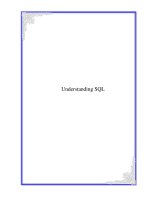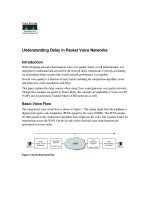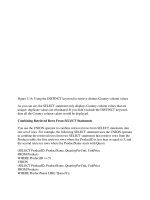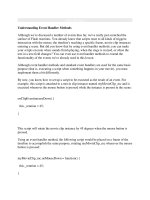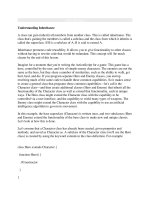Tài liệu Understanding SQL ppt
Bạn đang xem bản rút gọn của tài liệu. Xem và tải ngay bản đầy đủ của tài liệu tại đây (395.17 KB, 45 trang )
Understanding SQL
A1
Part 9
Articles
A Understanding SQL A1
B Exporting Data A45
C Visual Basic Function Reference A49
D Internet Explorer Web Page Color Names A59
Part 9: Articles
A3
Part 9: Articles
Article A
Understanding SQL
SQL Select Queries . . . . . . . . . . . . . . . . A4 SQL Action Queries . . . . . . . . . . . . . . . . A38
Underlying every query in Microsoft Access is the SQL database command language. Although
you can design most queries using the simple Access design grid (or the view, function, or
stored procedure designer in an Access project file), Access stores every query you design as an
SQL command. When you use one of the designers, Access creates the SQL for you. However,
for advanced types of queries that use the results of a second query as a comparison condition,
you need to know SQL in order to define the second query (called a subquery). Also, you cannot
use the design grid to construct all the types of queries Access is capable of handling; you
must use SQL for some of them. As you learned in Chapter 18, “Building Queries in an Access
Project,” understanding SQL is essential to building queries in SQL Server.
Note
This article does not document all the syntax variants accepted by Access, but it does
cover all the features of the SELECT statement and of action queries. Wherever possible,
ANSI-standard syntax is shown to provide portability across other databases that also support
some form of SQL. You might notice that Access modifies the ANSI-standard syntax to a syntax
that it prefers after you define and save a query. You can find some of the examples shown in
the following pages in the ContactsDataCopy.mdb sample database. When an example is in
the sample database, you’ll find the name of the sample query in italics immediately preceding
the query in the text. For a discussion of the syntax conventions used in this article, see the
Conventions and Features Used In This Book section in the book’s front matter.
How to Use This Article
This article contains two major sections: SQL select queries and SQL action queries. Within
the first section, you can find keywords used in the SQL language in alphabetical order. You
can also find entries for the basic building blocks you need to understand and use in various
clauses: Column-Name, Expression, Search-Condition, and Subquery. If you’re new to SQL,
you might want to study these building block topics first. You can then study the major
clauses of a SELECT statement in the order in which they appear in a SELECT statement:
PARAMETERS, SELECT, FROM, WHERE, GROUP BY, HAVING, UNION, and ORDER BY.
In the second section, you can find a discussion of the syntax for the four types of queries
that you can use to update your database, also in alphabetical order: DELETE, INSERT,
SELECT INTO, and UPDATE. As you study these topics you’ll find references to some of the
major clauses that you’ll also use in a SELECT statement. You can find the details about
those clauses in the first section.
Article 1Article 1Chapter A1Chapter A1Chapter A1Chapter A1
Part 9: Articles
Microsoft Office Access 2003 Inside Out
Part 9: Articles
A4
SQL Select Queries
The SELECT statement forms the core of the SQL database language. You use the SELECT state-
ment to select or retrieve rows and columns from database tables. The SELECT statement syntax
contains six major clauses: SELECT, FROM, WHERE, GROUP BY, HAVING, and ORDER BY.
In an Access desktop database (.mdb), Microsoft Access implements four significant exten-
sions to the standard language: TRANSFORM, to allow you to build crosstab queries; IN, to
allow you to specify a remote database connection or to specify column names in a crosstab
query; DISTINCTROW in a SELECT statement, to limit the rows returned from the <table
list> to rows that have different primary key values in the tables that supply columns in the
<field list>; and WITH OWNERACCESS OPTION in a SELECT statement, to let you design
queries that can be run by users who are authorized to use the query, including those who
have insufficient access rights to the tables referenced in the query.
Note
When you save a query you have written in SQL in your database, Access often
examines your SQL command and adds brackets or extra parentheses to make the com-
mand easier to parse and compile. In some cases, Access restates complex predicates or
changes the ANSI-standard syntax to one it prefers. For this reason, the examples shown in
the book might not exactly match what you see in the sample queries when you open them
in SQL view. If you enter the SQL exactly as shown in the book, it will return the same result
as the sample query you find in the database.
Aggregate Functions: AVG, CHECKSUM_AGG, COUNT, MAX, MIN,
STDEV, STDEVP, SUM, VAR, VARP
See Table 8-1 (on page 297 of the printed book) in Chapter 8, “Building Complex Queries,”
and Table 18-1 (on page 649 of the printed book) in Chapter 18, “Building Queries in an
Access Project.”
BETWEEN Predicate
Compares a value with a range of values.
Syntax
<expression>[NOT] BETWEEN <expression> AND <expression>
Notes
The data types of all expressions must be compatible. Comparison of alphanumeric literals
(strings) in Access or a default installation of Microsoft SQL Server Data Engine (MSDE) is
case-insensitive.
Let a, b, and c be expressions. Then, in terms of other predicates, a BETWEEN b AND c is
equivalent to the following:
(a >= b)AND(a <= c)
Part 9: Articles
Article 1Article 1Chapter A1Chapter A1Chapter A1Chapter A1
Understanding SQL
A5
Part 9: Articles
a NOT BETWEEN b AND c is equivalent to the following:
(a < b)OR(a > c)
The result is undefined if any of the expressions is Null.
Example
To determine whether the SoldPrice is greater than or equal to $100 and less than or equal to
$500, enter the following:
SoldPrice BETWEEN 100 AND 500
Also see Expression, SELECT Statement, Subquery, and WHERE Clause in this article.
Column-Name
Specifies the name of a column in an expression.
Syntax
[[[]{table-name | select-query-name |
correlation-name}[]].][[]field-name[]]
Notes
You must supply a qualifier to the field name only if the name is ambiguous within the con-
text of the query or subquery (for example, if the same field name appears in more than one
table or query listed in the FROM clause).
The table-name, select-query-name, or correlation-name that qualifies the field name must
also appear in the FROM clause of the query or subquery. If a table or query has a correlation
name, you must use the alias, not the actual name of the table or query. (A correlation name
is an alias you assign to the table or query name in the FROM clause.)
You must supply the enclosing brackets in an Access desktop database (.mdb) only if
the name contains an embedded blank or the name is also a reserved word (such as
select, table, name, or date). Embedded blanks and enclosing brackets are not supported
in the ANSI standard. You can use names that have embedded blanks in SQL Server by
including a SET QUOTED IDENTIFIER ON command and then enclosing each non-
standard name in double quotes ("). When you open a query from an Access project,
Access automatically includes this command in the command stream that it sends to
SQL Server.
Also see FROM Clause, SELECT Statement, and Subquery in this article.
Article 1Article 1Chapter A1Chapter A1Chapter A1Chapter A1
Part 9: Articles
Microsoft Office Access 2003 Inside Out
Part 9: Articles
A6
Examples
To specify a field named Customer Last Name in a table named Customer List in an Access
desktop database (.mdb), use the following:
[Customer List].[Customer Last Name]
To reference the same column in a view, stored procedure, or function for SQL Server, use the
following:
"Customer List"."Customer Last Name"
To specify a field named StreetAddress that appears in only one table or query in the FROM
clause, enter:
StreetAddress
Comparison Predicate
Compares the values of two expressions or the value of an expression and a single value
returned by a subquery.
Syntax
<expression>{= | <> | > | < | >= | <=}
{<expression>|<subquery>}
Notes
Comparison of strings in Access or a default installation of Microsoft SQL Server Data
Engine (MSDE) is case-insensitive. The data type of the first expression must be compatible
with the data type of the second expression or with the value returned by the subquery. If the
subquery returns no rows or more than one row, an error is returned except when the select
list of the subquery is COUNT(*), in which case the return of multiple rows yields one value.
If either the first expression, the second expression, or the subquery evaluates to Null, the
result of the comparison is undefined.
Examples
To determine whether the sales date was in 2003, enter the following:
Year(DateSold) = 2003
To determine whether the invoice ID is not equal to 50, enter the following:
InvoiceID <> 50
To determine whether a product was sold in the first half of the year, enter the following:
Month(DateSold) < 7
Part 9: Articles
Article 1Article 1Chapter A1Chapter A1Chapter A1Chapter A1
Understanding SQL
A7
Part 9: Articles
To determine whether the date sold in the current row is less than the earliest order for
ProductID 1, enter the following:
DateSold <
(SELECT MIN(DateSold)
FROM tblContactProducts
WHERE ProductID = 1)
Also see Expression, SELECT Statement, Subquery, and WHERE Clause in this article.
EXISTS Predicate
Tests the existence of at least one row that satisfies the selection criteria in a subquery.
Syntax
EXISTS (<subquery>)
Notes
The result cannot be undefined. If the subquery returns at least one row, the result is True;
otherwise, the result is False. The subquery need not return values for this predicate; there-
fore, you can list any columns in the select list that exist in the underlying tables or queries or
use an asterisk (*) to denote all columns.
Example
To find all contacts that own at least one product, enter the following (qxmplContacts-
SomeProduct):
SELECT tblContacts.FirstName, tblContacts.MiddleInit, tblContacts.LastName
FROM tblContacts
WHERE EXISTS
(SELECT *
FROM tblContactProducts
INNER JOIN tblProducts
ON tblContactProducts.ProductID = tblProducts.ProductID
WHERE tblContactProducts.ContactID = tblContacts.ContactID
AND tblProducts.TrialVersion = 0);
Note
In this example, the inner subquery makes a reference to the tblContacts table in the
SELECT statement by referring to a column in the outer table (tblContacts.ContactID). This forces
the subquery to be evaluated for every row in the SELECT statement, which might not be the
most efficient way to achieve the desired result. (This type of subquery is also called a correlated
subquery.) Whenever possible, the database query plan optimizer solves the query efficiently by
reconstructing the query internally as a join between the source specified in the FROM clause
and the subquery. In many cases, you can perform this reconstruction yourself, but the purpose
of the query might not be as clear as when you state the problem using a subquery.
Article 1Article 1Chapter A1Chapter A1Chapter A1Chapter A1
Part 9: Articles
Microsoft Office Access 2003 Inside Out
Part 9: Articles
A8
See also Expression, SELECT Statement, Subquery, and WHERE Clause in this article.
Expression
Specifies a value in a predicate or in the select list of a SELECT statement or subquery.
Syntax
[+ | -] {function |[(]<expression>[)] | literal |
column-name}[{+ | - | * | / | \ | ^ | MOD | &}
{function | [(]<expression>[)] | literal |
column-name}]...
Notes
function—You can specify one of the SQL aggregate functions: AVG, COUNT, MAX, MIN,
STDEV, STDEVP, SUM, VAR, or VARP; however, you cannot use an SQL aggregate function
more than once in an expression. In a desktop database (.mdb), you can also use any of the
functions built into Access or any function you define using Visual Basic. In a project file
(.adp), you can use any of the SQL Server built-in functions.
[(]<expression>[)]—You can construct an expression from multiple expressions separated
by operators. Use parentheses around expressions to clarify the evaluation order. (See the
examples later in this section.)
literal—You can specify a numeric or an alphanumeric constant. You must enclose an alpha-
numeric constant in single quotation marks in a project file (.adp) or single or double quo-
tation marks in a desktop database (.mdb). To include an apostrophe in an alphanumeric
constant, enter the apostrophe character twice in the literal string; or, in a desktop database,
you can also choose to enclose the literal string in double quotation marks. If the expression
is numeric, you must use a numeric constant. In a desktop database (.mdb), enclose a date/
time literal within pound (#) signs, and any date/time literal you enter in SQL view must fol-
low the U.S. mm/dd/yy (or mm/dd/yyyy) format. This might be different from the format
you use on the query design grid, which must follow the format defined for Short Date Style
in your regional settings in Windows Control Panel. In a project file (.adp), you must enclose
date or time literals in single quotes, and you can use any specification inside the quotes that
SQL Server can recognize as a date or time. For example, SQL Server recognizes any of the
following as a valid date literal:
’April 15, 2004’
’15 April, 2004’
’040415’
’04/15/2004’
’2004-04-15’
column-name—You can specify the name of a column in a table or a query. You can use a
column name only from a table or query that you’ve specified in the FROM clause of the
statement. If the expression is arithmetic, you must use a column that contains numeric data.
Part 9: Articles
Article 1Article 1Chapter A1Chapter A1Chapter A1Chapter A1
Understanding SQL
A9
Part 9: Articles
If the same column name appears in more than one of the tables or queries included in the
query, you must fully qualify the name with the query name, table name, or correlation
name, as in TableA.Column1. When a table or column name contains a blank or is a reserved
word (such as select, table, name, or date) in a desktop database (.mdb), you must enclose
each name in brackets, as in [Table A].[Column 1]. When a table or column name contains
a blank or is a reserved word in a project file (.adp), you must enclose each name in double
quotes, as in "Table A"."Column 1". Note that when you open a query in an Access project,
Access includes the required SET QUOTED IDENTIFIER ON command in the command
string. However, if you execute an SQL Server query from a desktop database with a pass-
through query, you must include this command in the pass-through query. Although in ANSI
SQL (and SQL Server) you can reference an output-column-name anywhere within an expres-
sion, Microsoft Access supports this only within the <field list> of a SELECT statement. Access
does not support references to named expression columns in GROUP BY, HAVING, ORDER
BY, or WHERE clauses. You must repeat the expression rather than use the column name. See
SELECT Statement later in this article for details about output-column-name.
+ | - | * | / | \ | ^ | MOD—You can combine multiple numeric expressions with arithmetic
operators that specify a calculation. If you use arithmetic operators, all expressions within an
expression must evaluate as numeric data types.
&—You can concatenate alphanumeric expressions by using the & operator in a desktop
database (.mdb). In a project file (.adp), use + as the concatenation operator.
Also see Column-Name, Predicates (BETWEEN, Comparison, EXISTS, IN, LIKE, NULL, and Quantified),
SELECT Statement, Subquery, and UPDATE Statement in this article.
Examples
To specify the average of a column named COST, enter the following:
AVG(COST)
To specify one-half the value of a column named PRICE, enter the following:
(PRICE * .5)
To specify a literal for 3:00
P
.
M
. on March 1, 2004, in a desktop database (.mdb), enter the
following:
#3/1/2004 3:00PM#
To specify a literal for 3:00
P
.
M
. on March 1, 2004, in a project file (.adp), enter the following:
’March 1, 2004 3:00PM’
To specify a character string that contains the name Acme Mail Order Company, enter the
following:
’Acme Mail Order Company’
Article 1Article 1Chapter A1Chapter A1Chapter A1Chapter A1
Part 9: Articles
Microsoft Office Access 2003 Inside Out
Part 9: Articles
A10
To specify a character string that contains a possessive noun (requiring an embedded apos-
trophe), enter the following:
’Andy’’s Hardware Store’
or in a desktop database you can also enter:
"Andy’s Hardware Store"
In a desktop database (.mdb), to specify a character string that is the concatenation of fields
from a table named Customer List containing a person’s first and last name with an interven-
ing blank, enter the following:
[Customer List].[First Name] & " " &
[Customer List].[Last Name]
In a project file (.adp), to specify a character string that is the concatenation of fields from a
table named Customer List containing a person’s first and last name with an intervening
blank, enter the following:
"Customer List"."First Name" + ’ ’ +
"Customer List"."Last Name"
FROM Clause
Specifies the tables or queries that provide the source data for your query.
Syntax
FROM {table-name [[AS] correlation-name]|
select-query-name [[AS] correlation-name]|
(<select-statement>) AS correlation-name |
<joined table>},...
[IN <"source database name"><[source connect string]>]
where <joined table> is
({table-name [[AS] correlation-name]|
select-query-name [[AS] correlation-name]|
<joined table>}
{INNER |{{LEFT | RIGHT | FULL}[OUTER]} JOIN
{table-name [[AS] correlation-name]|
select-query-name [[AS] correlation-name]|
<joined table>}
ON <join-specification>)
where <joined table> is the result of another join operation, and where <join-specification>
is a search condition made up of predicates that compare fields in the first table, query, or
joined table with fields in the second table, query, or joined table.
Part 9: Articles
Article 1Article 1Chapter A1Chapter A1Chapter A1Chapter A1
Understanding SQL
A11
Part 9: Articles
Notes
You can supply a correlation name for each table name or query name and use this correla-
tion name as an alias for the full table name when qualifying column names in the <field-
list>, in the <join-specification>, or in the WHERE clause and subclauses. If you’re joining a
table or a query to itself, you must use correlation names to clarify which copy of the table or
query you’re referring to in the select list, join criteria, or selection criteria. If a table name or
a query name is also an SQL reserved word (for example, Order), you must enclose the name
in brackets. In SQL Server, you must enclose the name of a table or query that is also an SQL
reserved word in double quotes. Note that when you open a query in an Access project,
Access includes the required SET QUOTED IDENTIFIER ON command in the command
string. However, if you execute an SQL Server query from a desktop database with a pass-
through query, you must include this command in the pass-through query.
Use INNER JOIN to return all the rows that match the join specification in both tables. Use
LEFT [OUTER] JOIN to return all the rows from the first logical table (where logical table is
any table, query, or joined table expression) joined on the join specification with any match-
ing rows from the second logical table. When no row matches in the second logical table, the
database returns Null values for the columns from that table. Conversely, RIGHT [OUTER]
JOIN returns all the rows from the second logical table joined with any matching rows from
the first logical table. A FULL [OUTER] JOIN returns all rows from the tables or queries on
both sides of the join, but only SQL Server supports this operation.
When you use only equals comparison predicates in the join specification, the result is called
an equi-join. The joins that Access displays in the design grid are equi-joins. Access cannot
display on the design grid any join specification that uses any comparison operator other
than equals (=)—also called a non-equijoin. If you want to define a join on a nonequals com-
parison (<, >, <>, <=, or >=) in Access, you must define the query using the SQL view. The
query designer in an Access project can display non-equijoins. When you join a table to itself
using an equals comparison predicate, the result is called a self-join.
SQL Server also supports a CROSS JOIN (with no ON clause). A CROSS JOIN produces the
same result as listing table or query names separated by commas with no JOIN specification
(a Cartesian product).
If you include multiple tables in the FROM clause with no JOIN specification but do include
a predicate that matches fields from the multiple tables in the WHERE clause, the database in
most cases optimizes how it solves the query by treating the query as a JOIN. For example:
SELECT *
FROM TableA, TableB
WHERE TableA.ID = TableB.ID
is solved by the database as though you had specified
SELECT *
FROM TableA
INNER JOIN TableB
ON TableA.ID = TableB.ID
Article 1Article 1Chapter A1Chapter A1Chapter A1Chapter A1
Part 9: Articles
Microsoft Office Access 2003 Inside Out
Part 9: Articles
A12
You cannot update fields in a table by using a recordset opened on the query, the query
datasheet, or a form bound to a multiple table query where the join is expressed using a table-
list and a WHERE clause. In many cases you can update the fields in the underlying tables
when you use the JOIN syntax.
When you list more than one table or query without join criteria, the source is the Cartesian
product of all the tables. For example, FROM TableA, TableB instructs the database to fetch all
the rows of TableA matched with all the rows of TableB. Unless you specify other restricting
criteria, the number of logical rows that the database processes could equal the number of
rows in TableA times the number of rows in TableB. When you include WHERE or HAVING
clauses, the database returns the rows in which the selection criteria specified in those clauses
evaluate to True.
Example
To select information about all companies and contacts and any products purchased, enter
the following (qxmplAllCompanyContactsAnyProducts):
SELECT tblCompanies.CompanyName, tblContacts.FirstName,
tblContacts.LastName, CP.ProductName, CP.DateSold, CP.SoldPrice
FROM ((tblCompanies
INNER JOIN tblCompanyContacts
ON tblCompanies.CompanyID = tblCompanyContacts.CompanyID)
INNER JOIN tblContacts
ON tblContacts.ContactID = tblCompanyContacts.ContactID)
LEFT JOIN
(SELECT tblContactProducts.ContactID, tblProducts.ProductName,
tblContactProducts.DateSold, tblContactProducts.SoldPrice
FROM tblProducts
INNER JOIN tblContactProducts
ON tblProducts.ProductID = tblContactProducts.ProductID
WHERE tblProducts.TrialVersion = 0) AS CP
ON tblContacts.ContactID = CP.ContactID;
Note
When you open the above query in Design view, you’ll find that Access saves the
inner <select-statement> with brackets as:
[SELECT tblContactProducts.ContactID, tblProducts.ProductName,
tblContactProducts.DateSold, tblContactProducts.SoldPrice
FROM tblProducts
INNER JOIN tblContactProducts
ON tblProducts.ProductID = tblContactProducts.ProductID
WHERE tblProducts.TrialVersion = 0]. AS CP
This is the internal syntax supported by the JET database engine, but the query designer
accepts the ANSI-standard syntax shown above.
Also see HAVING Clause, IN Clause, SELECT Statement, Subquery, and WHERE Clause in this article.
Part 9: Articles
Article 1Article 1Chapter A1Chapter A1Chapter A1Chapter A1
Understanding SQL
A13
Part 9: Articles
GROUP BY Clause
In a SELECT statement, specifies the columns used to form groups from the rows selected.
Each group contains identical values in the specified column(s). In Access, you use the
GROUP BY clause to define a totals query. You must also include a GROUP BY clause in a
crosstab query in Access. (See TRANSFORM Statement for details.)
Syntax
GROUP BY column-name,...
Notes
A column name in the GROUP BY clause can refer to any column from any table in the
FROM clause, even if the column is not named in the select list. If the GROUP BY clause is
preceded by a WHERE clause, the database creates the groups from the rows selected after it
applies the WHERE clause. When you include a GROUP BY clause in a SELECT statement,
the select list must be made up of either SQL aggregate functions or column names specified
in the GROUP BY clause.
Example
To find the average and maximum prices for products by category name, enter the following
(qxmplCategoryAvgMaxPrice):
SELECT tblProducts.CategoryDescription,
Avg(tblProducts.UnitPrice) AS AvgOfUnitPrice,
Max(tblProducts.UnitPrice) AS MaxOfUnitPrice
FROM tblProducts
WHERE tblProducts.TrialVersion = 0
GROUP BY tblProducts.CategoryDescription;
Also see Aggregate Functions, HAVING Clause, Search-Condition, SELECT Statement, and WHERE
Clause in this article.
HAVING Clause
Specifies groups of rows that appear in the logical table (a recordset) defined by a
SELECT statement. The search condition applies to columns specified in a GROUP BY
clause, to columns created by aggregate functions, or to expressions containing aggregate
functions. If a group doesn’t pass the search condition, the database does not include it in
the logical table.
Syntax
HAVING <search-condition>
Article 1Article 1Chapter A1Chapter A1Chapter A1Chapter A1
Part 9: Articles
Microsoft Office Access 2003 Inside Out
Part 9: Articles
A14
Notes
If you do not include a GROUP BY clause, the select list must be formed by using one or
more of the SQL aggregate functions.
The difference between the HAVING clause and the WHERE clause is that WHERE <search-
condition> applies to single rows before they are grouped, while HAVING <search-condition>
applies to groups of rows.
If you include a GROUP BY clause preceding the HAVING clause, the <search-condition>
applies to each of the groups formed by equal values in the specified columns. If you do not
include a GROUP BY clause, the <search-condition> applies to the entire logical table defined
by the SELECT statement.
Example
To find invoice amount for all invoices that total more than $150, enter the following (qxmpl-
TotalInvoices>150):
SELECT tblCompanies.CompanyName, tblInvoices.InvoiceID,
tblInvoices.InvoiceDate, Sum(tblContactProducts.SoldPrice) AS InvoiceTotal
FROM (tblCompanies
INNER JOIN tblInvoices
ON tblCompanies.CompanyID = tblInvoices.CompanyID)
INNER JOIN tblContactProducts
ON tblInvoices.InvoiceID = tblContactProducts.InvoiceID
GROUP BY tblCompanies.CompanyName, tblInvoices.InvoiceID,
tblInvoices.InvoiceDate
HAVING Sum(tblContactProducts.SoldPrice) > 150;
Also see Aggregate Functions, GROUP BY Clause, Search-Condition, SELECT Statement, and WHERE
Clause in this article.
IN Clause
In a desktop database (.mdb), specifies the source for the tables in a query. The source can be
another Access database; a dBASE, Microsoft FoxPro, or Paradox file; or any database for
which you have an ODBC driver. This is an Access extension to standard SQL.
Syntax
IN <"source database name"> <[source connect string]>
Enter "source database name" and [source connect string]. (Be sure to include the quotation
marks and the brackets.) If your database source is Access, enter only "source database name".
Enter these parameters according to the type of database to which you are connecting, as
shown in Table A-1.
Part 9: Articles
Article 1Article 1Chapter A1Chapter A1Chapter A1Chapter A1
Understanding SQL
A15
Part 9: Articles
Notes
The IN clause applies to all tables referenced in the FROM clause and any subqueries in your
query. You can refer to only one external database within a query, but if the IN clause points
to a database that contains more than one table, you can use any of those tables in your query.
If you need to refer to more than one external file or database, attach those files as tables in
Access and use the logical attached table names instead.
For ODBC, if you omit the DSN= or DATABASE= parameters, Access prompts you with a
dialog box showing available data sources so that you can select the one you want. If you omit
the UID= or PWD= parameters and the server requires a user ID and password, Access
prompts you with a login dialog box for each table accessed.
For dBASE, Paradox, and FoxPro databases, you can provide an empty string ("") for source
database name and provide the path or dictionary file name using the DATABASE= parame-
ter in source connect string instead, as in
"[dBase IV; DATABASE=C:\MyDB\dbase.dbf]"
Example
In a desktop database (.mdb), to retrieve the Company Name field in the Northwind Traders
sample database without having to attach the Customers table, you could enter the following:
SELECT Customers.CompanyName
FROM Customers
IN "C:\My Documents\Shortcut to NORTHWIND.MDB";
Table A1-1.
IN Parameters for Various Database Types
Database Name Source Database Name Source Connect String
Access "drive:\path\filename" (none)
dBASE III "drive:\path" [dBASE III;]
dBASE IV "drive:\path" [dBASE IV;]
dBASE 5 "drive:\path" [dBASE 5.0;]
Paradox 3.x"drive:\path" [Paradox 3.x;]
Paradox 4.x"drive:\path" [Paradox 4.x;]
Paradox 5.x"drive:\path" [Paradox 5.x;]
FoxPro 2.0 "drive:\path" [FoxPro 2.0;]
FoxPro 2.5 "drive:\path" [FoxPro 2.5;]
FoxPro 2.6 "drive:\path" [FoxPro 2.6;]
FoxPro 3.0 "drive:\path" [FoxPro 3.0;]
ODBC (none) [ODBC; DATABASE=defaultdatabase;
UID=user; PWD=password;
DSN=datasourcename]
Article 1Article 1Chapter A1Chapter A1Chapter A1Chapter A1
Part 9: Articles
Microsoft Office Access 2003 Inside Out
Part 9: Articles
A16
Also see SELECT Statement in this article.
IN Predicate
Determines whether a value is equal to any of the values or is unequal to all values in a set
returned from a subquery or provided in a list of values.
Syntax
<expression>[NOT] IN {(<subquery>) |
({literal},...) |<expression>}
Notes
Comparison of strings in Access or a default installation of Microsoft SQL Server Data
Engine (MSDE) is case-insensitive. The data types of all expressions, literals, and the column
returned by the subquery must be compatible. If the expression is Null or any value returned
by the subquery is Null, the result is undefined. In terms of other predicates, <expression> IN
<expression> is equivalent to the following:
<expression>=<expression>
<expression> IN (<subquery>) is equivalent to the following:
<expression>=ANY(<subquery>)
<expression> IN (a, b, c,...), where a, b, and c are literals, is equivalent to the following:
(<expression>=a)OR(<expression>=b)OR
(<expression>=c)...
<expression> NOT IN ... is equivalent to the following:
NOT (<expression>IN...)
Examples
To test whether StateOrProvince is on the West Coast of the United States, enter the following:
[StateOrProvince] IN (’CA’, ’OR’, ’WA’)
To list all contacts who have not purchased a multi-user product, enter the following (qxmpl-
ContactsNotMultiUser):
SELECT tblContacts.ContactID, tblContacts.FirstName,
tblContacts.MiddleInit, tblContacts.LastName
FROM tblContacts
WHERE tblContacts.ContactID NOT IN
(SELECT ContactID
FROM tblContactProducts
Part 9: Articles
Article 1Article 1Chapter A1Chapter A1Chapter A1Chapter A1
Understanding SQL
A17
Part 9: Articles
INNER JOIN tblProducts
ON tblContactProducts.ProductID = tblProducts.ProductID
WHERE tblProducts.CategoryDescription = ’Multi-User’);
Also see Expression, Quantified Predicate, SELECT Statement, Subquery, and WHERE Clause in this
article.
LIKE Predicate
Searches for strings that match a pattern.
Syntax
column-name [NOT] LIKE match-string [ESCAPE escape-character]
Notes
String comparisons in Access or in a default installation of Microsoft SQL Server Data Engine
(MSDE) are case-insensitive. If the column specified by column-name contains a Null, the
result is undefined. Comparison of two empty strings or an empty string with the special
asterisk (*) character (% character in SQL Server) evaluates to True.
You provide a text string as a match-string value that defines what characters can exist in
which positions for the comparison to be true. Access and SQL Server understand a number
of wildcard characters (shown in Table A-2) that you can use to define positions that can
contain any single character, zero or more characters, or any single digit.
You can also specify in the match string that any particular position in the text or memo field
can contain only characters from a list that you provide. To define a list of comparison charac-
ters for a particular position, enclose the list in brackets ([ ]). You can specify a range of charac-
ters within a list by entering the low-value character, a hyphen, and the high-value character, as
in [A–Z] or [3–7]. If you want to test a position for any characters except those in a list, start the
list with an exclamation point (!) in a desktop database or a caret symbol (^) in a project file.
If you want to test for one of the special characters *, ?, #, and [ (and _ or % in a project file),
you must enclose the character in brackets. Alternatively, in a project file, you can specify an
ESCAPE clause. When you place the escape character in the match string, the database
Table A1-2.
Wildcard Characters for String Comparisons
Desktop Database Project File Meaning
? _ Any single character
* % Zero or more characters (used to define leading,
trailing, or embedded strings that don’t have to
match any of the pattern characters)
# [0–9] Any single digit

